Use 'Print preview' to check the number of pages and printer settings.
Print functionality varies between browsers.
Printable page generated Thursday, 20 November 2025, 12:50 AM
Health Management, Ethics and Research Module: 3. Planning Health Programmes
Study Session 3 Planning Health Programmes
Introduction
Planning is an important skill for Health Extension Practitioners because it is a key management function for all healthworkers and health managers. Planning is the process of determining in advance what should be accomplished – when, by whom, how and at what cost.
Regardless of whether it is planning long-term programme priorities or a two-hour meeting, the planning aspect of management will be a major contributor to your success. Stated simply: ‘If you don’t know where you are going, then you won’t know whether you have arrived!’
In this study session you will learn the basic ideas about planning, whether related to a particular task or project, or to your ongoing work. You will study an eight-stage model of the planning process and learn useful techniques for planning and allocating work. You will also learn how to engage individuals, groups, community members and different stakeholders in the planning process.
Learning Outcomes for Study Session 3
When you have studied this session, you should be able to:
3.1 Define and use correctly all of the key words printed in bold. (SAQs 3.1, 3.2 and 3.4)
3.2 Explain the importance of planning in healthcare management. (SAQs 3.1 and 3.4)
3.3 Describe the difference between strategic and operational planning. (SAQs 3.2 and 3.3)
3.4 Describe the eight stages of operational planning, as they relate to healthcare management. (SAQ 3.3)
3.1 Planning processes
What is planning? Remember you learned something about planning in Study Session 2.
Planning is forecasting and thinking about things that may happen in the future. The planning process will help you to decide what needs to be done to achieve health improvements in your community.
However, knowing what planning is will not be enough. It is also important to know why you need a healthcare plan in the first place. As a Health Extension Practitioner assigned to a village your aim is to achieve the health goals of that specific community. Primarily, you need a clear understanding of what needs to be done and why you need to do it. Secondly, you can’t do everything at one time, so you will need to prioritise and make decisions. Thirdly, you may have limited resources that will prevent you from doing everything, so you need to decide which actions will bring most benefit in your work. Fourthly, you need to communicate your intentions to others, and finally, you need a guide for the day-to-day implementation of your health work.
These are five very good reasons why healthcare planning is important for you to reach the health goal of your community.
What do you think are the most important parts of planning for Health Extension Practitioners?
In order to plan their activities properly Health Extension Practitioners have to understand what needs to be done, then decide which are the most important things to do first and which will bring most benefit to their community. They need to let everyone know what they are doing and develop a stepwise plan of action.
3.2 Types of planning
There are two types of planning commonly used in the health sector: strategic planning and operational planning. In this study session you will learn what strategic planning means, and then focus in detail on operational plans as these are most important for Health Extension Practitioners.
3.2.1 Strategic planning
Strategic planning is the process of determining what the health sector should be achieving in the future and how it will carry out the actions necessary to bring about those achievements. Top-level managers develop strategic plans in order to achieve their strategic goals. Usually strategic planning covers the long term and the specific actions to be taken in the next five to ten years. It is about the ‘bigger picture’ and it shows a ‘map’ of where the health sector is aiming to be in the future.
It is through strategic planning that the health sector determines its priorities and the strategies that are likely to help the nation to achieve its overall health. The Ethiopian Health Sector Development Plans (HSDP I, II, III and IV) are typical examples of strategic planning for the health sector at national level.
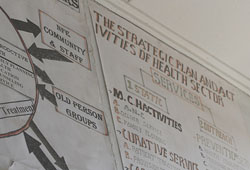
Who is responsible for strategic planning?
Strategic planning is usually done by senior managers at Federal Ministry of Health (FMOH) level, or the politicians responsible for the health of entire regions. Extension Practitioners need to be aware of strategic plans so they can implement them, but usually they won’t be involved in setting out those plans in the first place.
3.2.2 Operational planning
Operational planning refers to the action plans that guide your day-to-day work. Without a strategic plan you don’t know where you are going or why you are going there. But without an operational plan, it is likely that the strategic plan will remain a distant dream and you will not get there anyway.
An operational plan is an instrument for implementing the strategic plan. Operational plans are developed by managers nearer the frontline in order to establish actions that are necessary for the achievement of operational goals. Operational plans are short-term plans that cover time periods of up to one year, so they are usually referred to as annual operational plans. Good operational plans should comprise eight stages, as you will see in the next section. The stages of planning can be applied in the planning of any health programme.
3.3 Stages of operational planning
Once the Ethiopian FMOH sets a strategic plan, you may be involved in the district (woreda) planning process to develop operational plans for improving the health of your community (Figure 3.2).

An operational plan outlines important answers to such fundamental questions as:
- What needs to be done?
- How will it be done?
- Who will do it?
- By when must it be done?
- What resources are needed to do it?
There are eight stages in the operational planning process (Box 3.1).
Box 3.1 Stages in planning processes
Stage 1 Situational analysis
Stage 2 Problem identification and prioritisation
Stage 3 Setting objectives
Stage 4 Strategy formulation
Stage 5 Identify and sequence activities
Stage 6 Identify resources
Stage 7 Prepare action plans and schedules
Stage 8 Monitoring
3.3.1 Situational analysis
Situational analysis is the first stage in the operational planning process. It is the stage where you need to:
- Gather reliable information about the causes of health problems in the community, including from local people who will benefit from any interventions.
- Identify the health situation of the community and identify where affected population groups are located geographically.
- Discover what is currently being done to resolve the identified needs and who is doing it.
- Investigate how well identified needs have been addressed in the past and consider how you could collaborate with others in the community in order to address current needs.
SWOT analysis
SWOT analysis is a tool that can help you analyse situations more easily in your planning process. SWOT stands for:
S = Strengths
W = Weaknesses
O = Opportunities
T = Threats.
The purpose of the SWOT analysis is to identify the internal strengths and weaknesses of an organisation or project, and the external opportunities and threats the organisation or project faces.
The best time to do a SWOT analysis is after you have reviewed progress and completed an environmental scan. The process can be done for the Health Post and the community.
Case Study 3.1 Village level SWOT analysis
In village A community members and kebele leaders are concerned about health issues and work closely with their Health Extension Practitioners.
Several health promoters have volunteered to work with the HEPs. Most community members make their living from selling coffee, which makes them economically stronger than similar nearby villages, and literacy rates are higher than in neighbouring villages. In summer there is frequent flooding and it is also a malarial area. The FMOH has developed a five-year strategic plan for the health sector in this region. However, although the Health Extension Practitioners are busy and work hard, they don’t have a health plan and they don’t know how to measure their performance. Communication skills amongst them are weak.
Read the case study and attempt a SWOT analysis of the situation in village A. Construct a table under the headings: Strengths, Weaknesses, Opportunities and Threats, and enter your analysis in the relevant boxes.
When you have finished, compare your analysis with Table 3.1, which shows a SWOT analysis of village A. You can see how setting out the analysis like this helps to clarify the situation and points the way to possible ways to improve things.
Table 3.1 SWOT analysis of village A. Strengths Weaknesses Hard working Health Extension Practitioners
Motivated workers and volunteers
Good support from kebele leaders
Absence of a health plan
Weak recording systems
Poor communication skills
Opportunities Threats Good strategic health policy
Literacy rate high
High monthly income in community
Volunteer health promoters recruited
Flood
Malaria
3.3.2 Problem identification
A problem is a perceived gap between what something is and what that thing should ideally be. Gathering information about the root causes of health problems is necessary to identify the health problems that exist in the community. Information gathered should also include those people who will benefit from the interventions.
Case Study 3.2 Identifying a local problem
There is a flood in your village which may result in an acute outbreak of diarrhoeal disease. The community may not realise that this could contaminate the river water they are using for drinking. But as a Health Extension Practitioner you understand what this situation could develop into. Hence, you are able to identify this as a potential problem.
Why is the flood in the village identified as a potential problem?
Many people in the village have diarrhoea and sanitation in the village is poor. If faeces get into the river water used for drinking, then the infection may spread resulting in a widespread outbreak of diarrhoeal disease.
In order to solve the identified problem, first try to define it properly. You should identify all possible causes and try to address or remove the causes of the problem. A useful technique is to group the identified health problems together under specific headings. Table 3.2 shows an example of this approach.
| Health problems | Health service problems | Community problems |
|---|---|---|
Malaria Diarrhoea Malnutrition | Lack of supervision Insufficient drugs Lack of trained personnel | Lack of safe water supply |
How could problem identification help you tackle health problems?
Unless you understand the full extent of the problems, as set out for example in Table 3.2, you won’t be able to plan ways to tackle them effectively.
3.3.3 Prioritisation
As a Health Extension Practitioner you will be expected to prioritise and make strategic choices in order to implement your health plan. One of the important skills you need is the skill of prioritising. When you set priorities, you decide what is most important to tackle first.
You might think every problem is a priority and find it difficult to choose. One way to determine priority problems is to apply a set of selection criteria that establish a standard by which something can be measured. You can ask yourself the questions in Box 3.2 to help understand how serious and urgent a problem is.
Box 3.2 Selection criteria for evaluating a health problem
Does the problem:
- affect a large number of people, e.g. malaria, AIDS?
- cause high infant mortality, e.g. malnutrition, neonatal tetanus?
- affect maternal health, e.g. postpartum haemorrhage?
- affect rural development?
- cause great concern to the whole community?
In your community there is a lot of infestation with intestinal parasites. How could you use the criteria in Box 3.2 to evaluate this health problem?
Intestinal parasites do affect a large number of people, but they are not a direct cause of infant mortality and they don’t usually affect maternal health seriously either. But they may cause low energy levels and therefore be of general concern to your community, and they may also affect rural development to some extent. You could therefore say that intestinal parasites do need tackling, but other diseases may take priority because they are even more severe or more urgent.
3.3.4 Setting objectives
In order to plan effectively you need to be clear about what you and your work group are trying to achieve. You will need to review what needs to be done, and determine your priorities. Objectives include the steps to be taken in pursuit of agreed goals, such as those in the strategic plans set by the wider health service. However, you need to base your objectives on the local context and the capacity of your community.
There are two important reasons for setting objectives:
- A clear objective is essential to create a definite plan. For example, the objective could be to increase the number of families in your community using insecticide treated bed nets.
- Setting objectives enables results to be evaluated. When a programme has no stated or known objectives its outcome cannot be evaluated. For example, the objective could be to increase the number of families using insecticide treated bed nets by 50% in one year (Figure 3.3). Objectives are usually time-limited, i.e. to be achieved in a certain number of weeks, months or years.
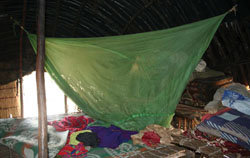
If 84 families in your community currently use bed nets and your objective is to increase this by 50% over the next year, how many families in your community should be using the nets by this time next year?
50% of 84 = 42. Therefore another 42 families should be protected, bringing the total to 84 + 42 = 126 families.
SMART objectives
Objectives must satisfy certain criteria; they must be relevant, feasible, and observable or measurable.
An objective is relevant if it either fits in with general health policy or relates to a problem that needs to be solved. An objective is feasible if it can be achieved, if the resources are available and any obstacles can be overcome. An objective is measurable when the outcome or result can be stated in numbers. For example, the objective that infant mortality will be reduced by 66% is measurable.
Consider this objective: ‘All babies delivered at the Health Post should be vaccinated with BCG.’ Is it measurable?
Yes, this is a measurable objective – but only at the end of a specified time period, such as a year, when the number of babies born and the number of babies vaccinated can be compared.
All objectives should be SMART, which stands for:
S = Simple or Straightforward (understandable by everyone involved)
M = Measurable (the outcomes can be measured to demonstrate that the objective has been achieved)
A = Attainable (the outcome is possible to achieve)
R = Realistic (achievable with available resources)
T = Time-framed (achievable within the time).
Your SMART objective is to train at least 180 model households in all the health extension packages by the end of next year. Is this objective measurable (M) and time-framed (T)?
Yes. The number of model households that have been trained by the target date can be counted to demonstrate if the objective has been achieved, and it is time-framed because it has to be completed by the end of next year.
3.3.5 Reviewing your objectives
You need to constantly review your objectives by measuring the outcomes, so that you can change the way that you are working, if necessary. While the vision and overall goal is fixed by the health sector strategic plan, your community-level strategy is not. You can and should change it if it doesn’t seem to be working.
Case Study 3.3 Using SMART objectives to review your performance
Your SMART objective is to increase condom use by 40% among couples in your community within one year. You have chosen the strategy of training 15 peer educators on how to use condoms consistently and correctly to achieve this purpose. You met all your training targets and in monitoring and evaluating the outcomes you found that condom use among couples has increased by 55% after a year.
Are your objectives being met by the way that you have chosen to tackle this problem in your community?
Yes; your strategy of training peer educators to achieve behaviour change among couples is succeeding and does not need to be altered.
Case Study 3.4 SMART objectives can identify a problem
Your SMART objective is to increase the uptake of contraceptive pills by 25% within one year among the women of childbearing age in your village. You chose the strategy of using outreach workers to distribute the pills from house to house. In monitoring and evaluating the outcomes at the end of the year, you found that most women in the community were not using the pills they received.
Are your objectives being met by the way that you have chosen to tackle this problem in your community, or should you redirect some of your resources to offer more choice of family planning methods?
Your objectives are not being met and you should think about a change of strategy and perhaps redirect your resources.
3.3.6 Identify and sequence activities
This is the stage where you already know what you are trying to achieve and need to list all the activities and place them in the correct sequence according to their importance and timing. You should identify any dependencies, i.e. which activities cannot start until others have been completed, since this is the factor that will determine your overall sequencing. Identify if any activities could possibly be undertaken at the same time. Table 3.3 sets out an example of a checklist of sequenced activities.
| Sequence of activities | Time target | Responsible person |
|---|---|---|
| Visit the community for discussions with community members to identify model households for training | January 12 | Health Extension Practitioner |
| Identify model households | January 12 | Community |
| Meet the kebele leader to secure the community hall | January 13 | Health Committee |
| Prepare health education materials and posters to teach model families | January 14–16 | Health Extension Practitioner |
| Educational materials ordered | January 17 | Health Extension Practitioner |
| Educational material received | January 27 | Health Extension Practitioner |
| Funds requested for Health Extenstion Practitioners daily expenses | January 27 | Health Extension Practitioner |
| Funds obtained | February 10 | |
| Programme start date | February 20 |
Look closely at the list of activities in Table 3.3. Why do you think that setting out a detailed timing checklist like this will help with planning the training of these model households?
By looking through this detailed checklist you can think through all the stages of preparing for the training. Not all plans work to the schedule you have planned and changing the dates may be necessary – but the sequence should remain the same.
3.3.7 Identify the resources
This is the time when you have to consider what resources will be needed to complete your health project activities. Once you have clarified the tasks to be done and the sequence in which the tasks must be carried out, you should be able to calculate what resources you will need more accurately (Figure 3.4). The resources you need to carry out an action plan include: staff, accommodation, power, equipment and materials. Time, skill and information are also important to be considered in resource calculations. What all this usually means is money. Your budgets will summarise the monetary resources that you need in order to carry out your action plan (Table 3.4). You cannot prepare a budget until you have an action plan.
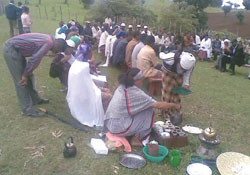
| Cost (birr) | ||
|---|---|---|
| People (salary) | 25 birr per day x 15 days x 2 Health Extension Workers | 750 |
| Health education materials | 100 | |
| Transportation allowance | 30 birr on average round trip x 2 Health Extension Workers | 60 |
| Refreshment | 5 birr/day x 2 times x 2 Health Extension Workers | 20 |
| Use of village hall | 30 | |
| Total cost | 960.00 | |
Look again at Table 3.4, which sets out the budget for training model households. What will happen if the costs are greater than this?
All budgets should be provisional and you should be prepared to revise them. Most budgets also have an item for ‘contingencies’ (possible unforeseen events) that can be used if more money is needed.
3.3.8 Prepare action plans and schedules
You now need to develop a practical action plan with respect to the objectives you have set (Figure 3.5). The following steps should help you do this. Box 3.3 shows an example of how the plan can be stated.
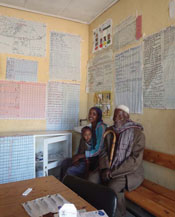
Box 3.3 Hygiene and sanitation plan
| The problem | Village J has no access to safe water and there is a high rate of neonatal death from diarrhoea. The community is difficult to reach because of poor roads. |
| Objective | To provide health education on hygiene and sanitation to 75% of mothers at household level. |
| Strategy and activities | The work is to be done by model households. The strategy is to train a Health Extension Practitioner who will then train the model households. |
| Resources | Health Extension Practitioner X will deliver refresher training on hygiene and sanitation to households. |
| Organisation | The training of model households will take place in the village hall. |
| Control | Each model household will keep a simple record of the number of women reached. |
Look at the plan in Box 3.3. How will you know if a plan has been effective?
If lots of mothers are taught about hygiene and sanitation the plan could be considered to be effective. But the real test will be if there are fewer deaths from diarrhoea in the future.
3.3.9 Monitoring
Monitoring is a technique by which you can check that everything is continuing to go according to plan.
Monitoring, in the context of the action plan, addresses questions such as:
- Are outputs being achieved within the timeframes?
- Are resources being efficiently and effectively used?
- Have you maximised the use of resources?
- Are you doing what you said you would do and if not, why not?
- Are you collaborating with other services?
When you do your monitoring, you need to identify what information should be collected (Figure 3.6). Don’t just collect information for the sake of having it; you must have a purpose, a reason for collecting the information. The questions to ask are:
- What sort of information do we need?
- How will we use the information?
- How can it be collected with the least possible trouble?
- Who will collect it?
- Who will analyse it?
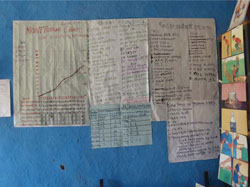
Summary of Study Session 3
In Study Session 3, you have learned that:
- Planning is forecasting and thinking about things that may happen in the future.
- In healthcare management you need to plan in order to have a clear understanding of what needs to be done and why you need to do it. Furthermore, it helps you to prioritise health problems so that limited resources are used for actions that will bring most benefit.
- In healthcare management there are two types of planning process: strategic planning and operational planning. Strategic planning is set at a higher level, while operational planning is done by people doing the frontline work, such as Health Extension Practitioners.
- There are eight stages of healthcare planning: situational analysis, problem identification and prioritisation, objective setting, strategic formulation, sequencing of activities, resource allocation, action planning, and monitoring and control.
- Objectives are essential for making plans and for measuring results. An objective has to be SMART which means Specific, Measurable, Attainable, Realistic and Time-framed.
Self-Assessment Questions (SAQs) for Study Session 3
Now that you have completed this study session, you can assess how well you have achieved its Learning Outcomes by answering the following questions. Write your answers in your Study Diary and discuss them with your Tutor at the next Study Support Meeting. You can check your answers with the Notes on the Self-Assessment Questions at the end of this Module.
SAQ 3.1 (tests Learning Outcomes 3.1 and 3.2)
Why do you think planning your health activities and developing a healthcare plan is important to the health of your community?
Answer
Planning your health activities and developing a healthcare plan is important to the health of your community because it is the only way that you will be able to make sure that all the resources that are available are used properly. Proper planning is an essential part of ensuring that the work of the healthcare team is carried out efficiently and effectively.
SAQ 3.2 (tests Learning Outcomes 3.1 and 3.3)
What is the difference between strategic planning and operational (or annual) planning?
Answer
Strategic planning creates the wider picture and gives an overall direction to health work in an entire region or nation. Operational planning is carried out at grassroots levels by the people who are going to be responsible for the plans in each village or community.
SAQ 3.3 (tests Learning Outcomes 3.3 and 3.4)
What are the steps involved in operational healthcare planning and why are they important to consider when planning your health activities?
Answer
The steps involved in operational healthcare planning include:
- situational analysis (detailing what is the problem)
- problem identification and prioritisation (setting out which problem should be tackled first)
- setting objectives (to decide what needs to be done)
- strategy formulation (to decide how to tackle each of the problems)
- identify and sequence activities (to establish the order in which to tackle the problems)
- identify resources
- prepare action plans and schedules.
Of course all health activities must also be monitored to determine progress.
SAQ 3.4 (tests Learning Outcomes 3.1 and 3.2)
In your village there is a high incidence of malaria. Explain why you might carry out a situational analysis followed by a SWOT analysis to focus on this problem.
Answer
If there is a high incidence of malaria in your village you might carry out a situational analysis to determine exactly what the problem is. This could be followed by a SWOT analysis to focus on the problem. Looking in turn at Strengths, Weaknesses, Opportunities and Threats will help you clarify the problem and point towards possible ways of tackling it.